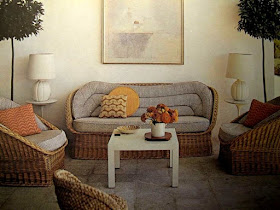In 1935, Wood offered Baldwin thirty-five dollars a week to come to New York and join her firm, an offer he accepted immediately. From Wood, he learned what he said were the guiding principles of his profession, ''the importance of the personal, of the comfortable, and of the new." he said. After Wood's death in 1950, he ran her firm for two years, before opening Baldwin & Martin, Inc. with his former assistant Edward Martin.
Baldwin's signature style was a mix of modernism and classicism. He believed in simplicity and a sleek, polished aesthetic. He never insisted on discarding all of a client's belongings, because he felt that working with some of their things gave the home a comfortable feel and retained the owner's personality.
Baldwin's signature pieces included built-in bookcases, brass étagères, white slipper chairs, Parsons tables, rattan and bamboo, and bold wall colors.
During the course of his career, Baldwin became known as the "dean of American interior decorators." (He detested the term "interior designer.") He counted among his clients the likes of Jacqueline Kennedy Onassis, Diana Vreeland, Greta Garbo, Paul & Bunny Mellon, Brooke Astor, and Cole Porter.
Baldwin retired in 1973 and turned the business over to his protégé Arthur E. Smith, but his influence is as strong today as it was at the height of his career.
From architecturaldigest.com, circawho.com, wsj.com, nytimes.com, and cjdellatore.com
 |
| architecturaldigest.com |
 |
| circawho.com |
 |
| byblye.com |





No comments:
Post a Comment